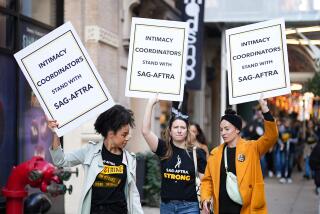The Fight for More, Better Female Roles : Unions Now Targeting Top Management of Networks, Studios in Campaign; Steady but Very Slow Progress Cited
- Share via
When Alan Ladd Jr. was president of the Ladd Co., he sat down one day with the executive staff of his production company and suggested that they go through scripts to see how they could better serve affirmative action.
“I am always asking, ‘Can this role be more interesting if it’s played by a woman rather than a man?’ ” Ladd said in an interview. He is now chairman and chief executive officer of MGM Pictures. “Often it can be. For instance, Sigourney Weaver’s role in ‘Alien’ was originally for a man.”
However, actresses can’t rely on such novel casting practices to get work. That’s why the Screen Actors Guild is trying to improve the employment picture for its female membership, numbering 29,647 (or 43% of the union’s members).
In the era of “Cagney & Lacey,” “Kate and Allie,” “Golden Girls,” “Designing Women” and “Murder, She Wrote” and the film box-office power of such stars as Jane Fonda and Meryl Streep, the 53% of the population that is female is still under-represented on the nation’s movie and TV screens. According to guild statistics compiled from information supplied by producers, women play just 33% of the roles in films and TV--as opposed to 31% in 1982.
An analysis of female characters on 1987-88 TV programs by the National Commission on Working Women found that “of 43 leading roles on new shows . . . only seven belong to women. Almost 20% of new shows have no female characters at all.”
“Male-dominated” programming, said the commission, “halts Hollywood’s slow but steady progress toward equitable portrayals of women on TV.”
In November, actors union president Patty Duke called a meeting with industry leaders to brainstorm about ways to open up more work for actresses. Attending were representatives from Aaron Spelling Productions, Columbia, MGM/UA, MTM Enterprises, NBC, Paramount, 20th Century Fox, Universal, Walt Disney, Warner Bros., the Alliance of Motion Picture and Television Producers, Directors Guild of America and the Producers Guild of America.
Timothy Blake, national chairwoman of the actors guild’s Women’s Conference Committee, characterized the get-together as successful.
“We got a great deal of enthusiasm at the meeting,” she said. “People were commenting, ‘We need more meetings like this. Remind us, and we’ll support you. We’re not sitting here thinking about where we can put women. But if you take on the responsibility of reminding us, we’ll put women in.’ ”
Enthusiasm aside, Rodney Mitchell, the guild’s affirmative action administrator, believes that changes will be slow in coming.
“I’ve learned to temper my expectations,” he said. “For several months jobs will open up; then it will be business as usual. You have to go back to raise their consciousness again.”
“It really is a consciousness-raising issue,” said Glenn Gumpel, associate national executive director of the directors’ guild, “and it’s up to SAG to do it. Those who do understand the issue have taken some action. We’d certainly look at any request SAG would make of us to inform our membership.”
In the past, the actors union has concentrated consciousness-raising efforts at middle-management levels. Now it is focusing on senior management.
Mitchell gave an example of why the guild is looking for action from the top: “A few years ago, employment data from SAG was leaked to the press, and Aaron Spelling’s production company came out at the bottom of the list in relation to minority hiring.”
Spelling, a philanthropist and a frequent supporter of liberal political causes, was said to be embarrassed and outraged. He sent an internal memo to personnel to make changes.
“You’ve got to get the top guys aware of the problem,” said Joel Thurm, vice president for casting at NBC. “A few years ago I remember going to meetings to deal with the non-representation of Hispanic people on television.
“Jeff Sagansky (now president of production at Tri-Star) was also there. At the time, he was in charge of the development of all NBC pilots and programs under (entertainment division president) Brandon Tartikoff. His being at the meeting raised his consciousness. Later I would get calls from him asking about changing a certain role to Hispanic.”
Said SAG’s Blake: “The studios and networks have to say it’s OK to develop projects for women and, especially, older women. (See story, this page.) They have to indicate they’re interested in seeing those kinds of scripts.”
“If the networks were demanding more female involvement and more honest female portrayals,” said producer Charles Fitzsimons, executive director of the producers guild, “there would be no choice but that writers, producers and directors would have to support it. Look at the enormous success of ‘Golden Girls.’ Not only is it all females, but it’s all females over 50.”
However, the actors’ union isn’t limiting its campaign to the board room.
“There are so many different players,” Mitchell said, “agents, directors, writers, producers, casting people, studios, networks. They all have to address the issue seriously and simultaneously. They all have a major role to play in the employment of actors.”
Casting directors can have an impact, particularly in the casting of so-called “nondescript” supporting roles or bit parts that do not specify a character’s sex.
“To me, a good casting director is one who is creative and open-minded. It’s easier to make changes with the supporting characters, but you can make a change anywhere,” said Nancy Nayor, vice president of theatrical talent at Universal.
“Most important, you can suggest a change. No one goes out there and says, ‘Let’s try not to make it a woman.’ If you’re handed a buddy movie for two women, you don’t think, ‘How can we make it for two guys?’ ”
Writers, too, have a major part to play in opening up new opportunities for women, and the Writers Guild later this year plans to start a series of round-table seminars to discuss the creation of characters other than white males.
“Writers will be talking to each other, agents, producers and others who have a lot to say about how writers write and get employment,” said Delle Chatman, chair of the guild’s human resources coordinating committee.
Although Chatman strongly supports the seminar program, she worries that it is simply a Band-Aid.
“We all need to learn that variety is the salvation of imagination,” Chatman said. “We need to look for unusual casting possibilities, if not out of social consciousness, then just to tickle our fantasies. It’s so much more entertaining.
“In this age of network Angst where viewership is dwindling, it stands to reason that innovation can’t hurt.”
More to Read
The biggest entertainment stories
Get our big stories about Hollywood, film, television, music, arts, culture and more right in your inbox as soon as they publish.
You may occasionally receive promotional content from the Los Angeles Times.









